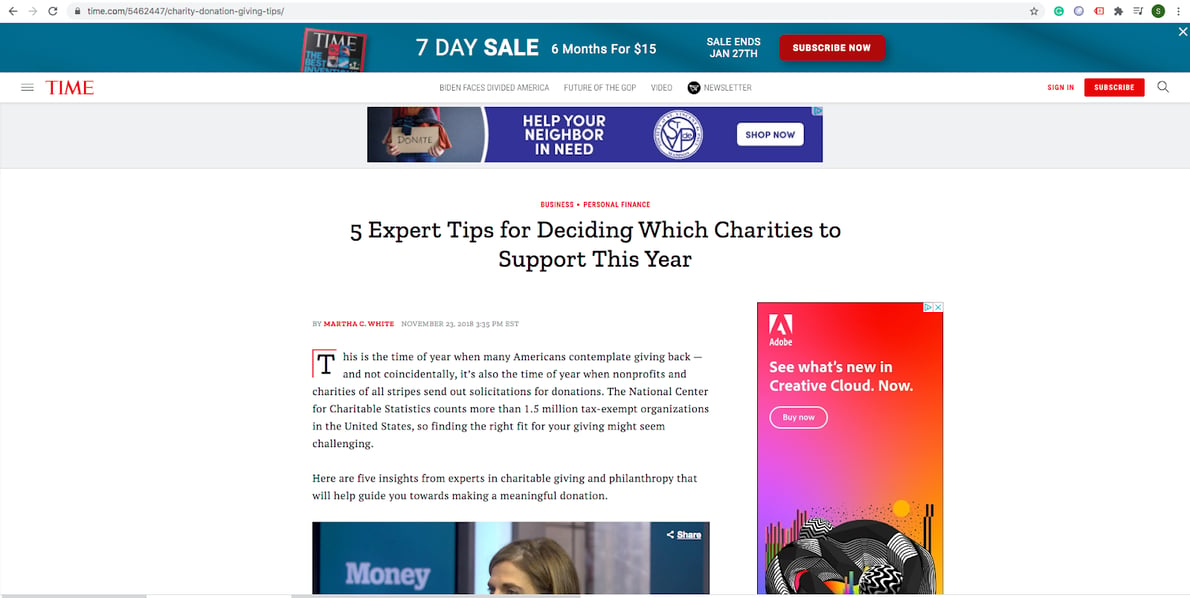
6 Common Questions About Targeted Display
What is it?
Targeted display is a technology that identifies users who are doing online research for a product or services and then shows them relevant ads as they surf the web, thus influencing their offline purchases.
Where are the ads displayed?
One of the things many business owners like about targeted display is they control many aspects of their ads. They can control how broad or narrow of an audience the campaign reaches based on their budget and strategy.
Specifically, ads are shown on websites and apps that allow ads to be placed on their site. Here are some examples:


How specific can or should I get with my targeting?
This is one of those questions where the answer is somewhat frustrating. It depends on your business goals and your business type. It also depends on what stage of the buying process your customer is in.
If you own a furniture store, ads could be programmed to reach customers visiting particular furniture stores around the area who are actively shopping.
They could also reach people that are in the research phase and visiting websites after Googling things like “Best mattress” or “Comparing memory foam to spring mattresses”.
That is why consulting with someone to help iron out your strategy first is important before you jump into using tools.
To learn several other options visit this page or reach out to us and we can customize a solution to your goals.
Our suggestion is to prioritize your budget on the customers closest to the buying stage and then to work backward from there. That way you’ll be able to capture the low-hanging fruit.
Keep in mind this is typically only 2-5% of the market so make sure you are planting a good portion of your budget into branding strategies also.
Who develops the ads?
Our branding experts will work with you to create the right messaging on the ads and we have a team of in-house designers who will help you create the ads. You are welcome to provide your own, but we do suggest trusting our experts to position your campaign for success.


What reports should I expect from my targeted display campaign?
We start all of our campaigns out by asking “What does success look like for your business?” One reason we ask this is to know what information is important for your business. Our experts will deliver a custom report to you on a monthly basis to ensure you have the information you need.
Keep in mind, targeted display is not designed to be a direct response tool like Google Pay Per Click Ads. Targeted display is primarily designed to position your ads in front of your customers at the right time and place. That way when they do decide to Google your service or product your brand is the one they recognize.
You will see some clicks to your website, but clicks are not the main measure of success for targeted display campaigns.
What should I look at to measure success?
A combination of online analytical tools, foot traffic, form submissions, and what all businesses love to see, an increase in revenue. In order to measure the success of a targeted display campaign, tracking metrics must be in place. Campaign metrics show a piece of the picture, but it takes a combination of the campaign and paying attention to offline trends to paint the full picture.
Google analytics can differentiate online organic traffic vs traffic funneled to your site via targeted display. UTM codes (Urchin tracking parameters) can help you navigate through the Google Analytics dashboard, allowing you to pinpoint when a consumer visited your page as a result of viewing a targeted display ad. UTM codes sound intimidating, but they are basically digital breadcrumbs so to trace where your web traffic came from. Here’s a great article about them if you want to learn more.
If you own a business where customers come to your physical store to buy from you then Geo-Fencing is a great tool. This will tell you how many consumers saw a display ad, and then came to your location.
A great example is a campaign executed for a jewelry store. The Geo-Fencing tool was used to target customers who came into the store. Within one month, the location recorded 19 consumers who visited the store, after being served a targeted display ad. The owner was able to attribute these visits as a success of the campaign.
Monitoring revenue increases during a campaign can also provide insight into the success of a campaign. Depending on the type of business, revenue could be coming from online sales or in-store purchases. How the campaign is set up, and what the overall goals of the campaign are, will help you determine where you should be seeing an increase in revenue from.
Should I use targeted display in my marketing strategy?
It depends on your strategy and what type of marketing tools you are comfortable with. It’s best to have a holistic marketing approach and fit the tools you need to reach your best customers. Targeted display may be a tool you should use, but it’s best to lead with a strategy-first mindset before you start throwing money at different tools. We’d love to help you assemble that strategy! Reach out and we’ll help you sort through all the marketing tools and prioritize which ones will get you the most bang for your buck.
Author Bio:

Walter Scheuer is an Interactive and Digital Campaign manager for Mid-West Family Madison. He started working for Mid-West Family as a Sales Assistant after completing his Bachelor degree in Marketing. He now has 3 years of Marketing experience, and enjoys the challenge of producing successful campaigns with measurable results. Outside of work, Walter can be found watching his favorite local sports teams, Milwaukee Bucks, Milwaukee Brewers, and the Green Bay Packers. Go Pack Go.



